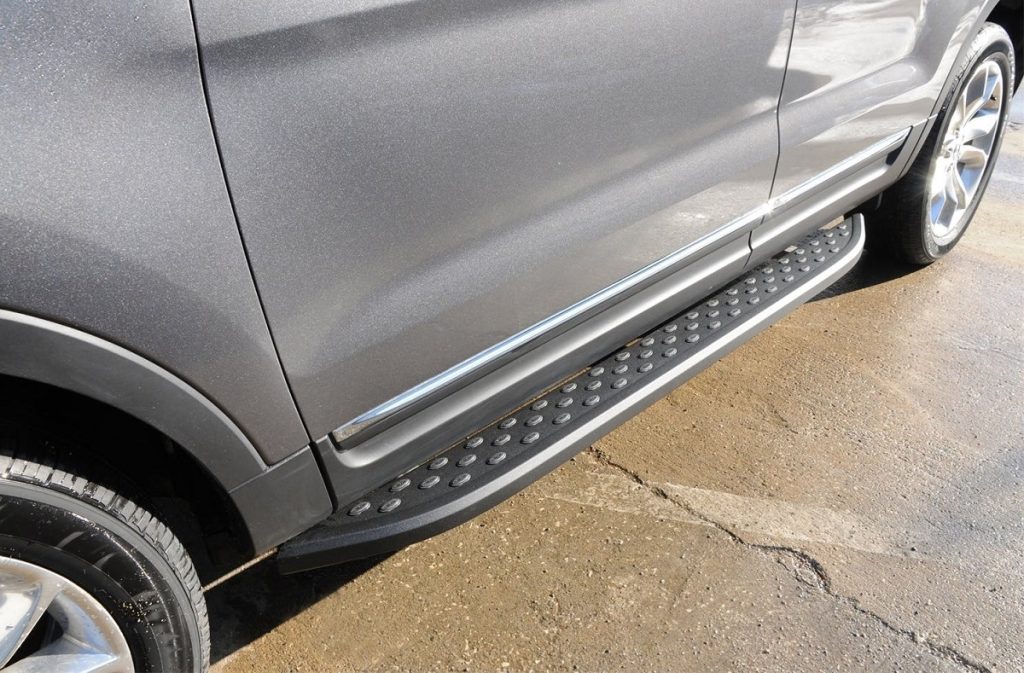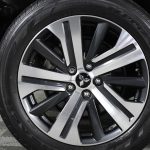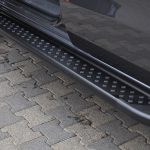Running boards, also known as nerf bars or side steps, are a popular accessory for vehicles, providing both functionality and style. They offer a convenient step for passengers to enter and exit tall vehicles, such as trucks and SUVs, while also serving as a protective barrier for the vehicle’s lower body panels. Additionally, running boards can enhance the appearance of a vehicle, adding a sleek and customized look.
Understanding Running Boards
Functionality
The primary function of running boards is to facilitate easier access to tall vehicles. Whether you’re loading groceries into the back of your SUV or helping elderly passengers climb into your truck, running boards provide a stable platform for stepping up into the vehicle. This functionality is particularly useful for individuals with mobility issues or small children who may struggle to climb into taller vehicles without assistance.
Protection
In addition to their accessibility benefits, running boards also offer protection for the vehicle’s lower body panels. When driving off-road or navigating through urban environments, vehicles are susceptible to damage from rocks, road debris, and other hazards. Running boards act as a barrier, shielding the vehicle’s sides from scratches, dents, and dings. This protective function not only preserves the appearance of the vehicle but also helps maintain its resale value over time.
Aesthetics
Beyond their practical benefits, running boards can significantly enhance the aesthetics of a vehicle. Available in a variety of styles, materials, and finishes, running boards allow vehicle owners to customize the look of their ride to suit their personal preferences. Whether you prefer the rugged appearance of black powder-coated steel or the sleek elegance of polished aluminum, there’s a running board option to complement any vehicle’s exterior.
Are Running Boards Truly Universal?
The term “universal” implies that a product is compatible with a wide range of vehicles without the need for modifications. However, when it comes to running boards, true universality is rare. Several factors influence whether a set of running boards will fit a particular vehicle:
Vehicle Make and Model
Different vehicle models have varying dimensions and body shapes, which can impact the placement and fitment of running boards. For example, running boards designed for a Ford F-150 may not be compatible with a Chevrolet Silverado due to differences in door height, wheelbase, and cab configuration.
Wheelbase
The length between the front and rear wheels can vary even within the same vehicle model, affecting the required length of the running boards. It’s essential to choose running boards that match your vehicle’s wheelbase to ensure proper fitment and functionality.
Cab Configuration
Running boards may differ depending on whether the vehicle has a regular cab, extended cab, or crew cab configuration. The number of doors and the placement of the cab steps can vary between these configurations, requiring different running board designs for optimal fitment.
Mounting Style
Running boards can be installed using different mounting methods, such as vehicle-specific brackets or universal clamps. The compatibility of these mounting options varies depending on the vehicle’s make and model, as well as its construction and design.
Selecting the Right Running Boards
To ensure compatibility and functionality, follow these steps when selecting running boards for your vehicle:
1. Research Your Vehicle
Start by identifying the make, model, and year of your vehicle. This information will help narrow down your options and ensure that you choose running boards that are compatible with your specific vehicle. (See Also: Are Bilstein 5100 Shocks Good? Discover Their Performance & Value)
2. Consider Your Needs
Determine the primary purpose of the running boards. Are you primarily seeking functionality, protection, aesthetics, or a combination of these factors? Understanding your priorities will help you choose the right running boards for your vehicle.
3. Measurements
Take accurate measurements of your vehicle’s wheelbase, ground clearance, and door height to ensure proper fitment. Running boards that are too long or too short can affect both the appearance and functionality of your vehicle.
4. Mounting Options
Decide on the preferred mounting method based on your vehicle’s configuration and your installation preferences. Some running boards require drilling for installation, while others can be mounted using existing factory holes or brackets.
5. Material and Finish
Choose running boards made from durable materials such as aluminum or stainless steel, and select a finish that complements your vehicle’s exterior. Powder-coated finishes offer enhanced durability and corrosion resistance, making them ideal for vehicles that will be exposed to harsh weather conditions or off-road environments.
6. Reviews and Recommendations
Research customer reviews and seek recommendations from automotive enthusiasts or professionals to find reputable brands and products. Reading about other customers’ experiences can help you make an informed decision and avoid potential issues with compatibility or quality.
Installation and Maintenance
Once you’ve selected the right running boards for your vehicle, proper installation is crucial to ensure safety and longevity. Follow the manufacturer’s instructions carefully or enlist the help of a qualified professional for installation. Here are some maintenance tips to keep your running boards in top condition:
Regular Cleaning
Keep your running boards clean by washing them with mild soap and water regularly. This helps prevent the buildup of dirt, grime, and road salt, which can cause corrosion over time. Be sure to clean both the tops and bottoms of the running boards to remove any debris that may accumulate underneath.
Inspect for Damage
Periodically inspect your running boards for signs of damage, such as dents, scratches, or loose mounting hardware. Address any issues promptly to prevent further damage and ensure continued functionality and safety.
Protective Coating
Consider applying a protective coating or wax to the running boards to enhance durability and resistance to corrosion. This extra layer of protection can help prolong the lifespan of your running boards and maintain their appearance over time.
Avoid Harsh Chemicals
When cleaning your vehicle, avoid using harsh chemicals or abrasive cleaners on the running boards, as they can damage the finish and compromise their integrity. Stick to mild soap and water or automotive-specific cleaning products to preserve the appearance and performance of your running boards.
Expert Tips for Selecting Running Boards
When it comes to choosing the right running boards for your vehicle, there are several expert tips to keep in mind. These tips can help ensure compatibility, functionality, and style, enhancing your overall driving experience. Let’s explore some expert recommendations for selecting the perfect running boards: (See Also: Will F150 Seats Fit In An F250? Upgrade Your Truck’s Interior!)
1. Consider Vehicle-Specific Options
Opting for running boards specifically designed for your vehicle’s make and model can ensure the best fit and compatibility. Vehicle-specific running boards are engineered to seamlessly integrate with your vehicle’s body, maximizing both aesthetics and functionality.
2. Prioritize Quality Materials
Investing in running boards made from high-quality materials, such as aluminum or stainless steel, can provide long-lasting durability and resistance to corrosion. Quality materials not only enhance the appearance of your vehicle but also ensure that your running boards can withstand the rigors of daily use and exposure to the elements.
3. Choose the Right Style
Consider the overall style of your vehicle when selecting running boards. Whether you prefer sleek and streamlined designs or rugged and off-road-ready styles, choosing running boards that complement your vehicle’s aesthetic can enhance its appearance and curb appeal.
4. Pay Attention to Installation
Proper installation is key to ensuring the safety and functionality of your running boards. Follow the manufacturer’s instructions carefully, and consider enlisting the help of a professional installer if you’re unsure about the process. Properly installed running boards will provide a secure and stable platform for entering and exiting your vehicle.
5. Factor in Maintenance Requirements
Different types of running boards may require varying levels of maintenance to keep them looking and performing their best. Consider the maintenance requirements of your chosen running boards and ensure that you’re prepared to clean and care for them regularly to maintain their appearance and functionality over time.
6. Seek Expert Advice
If you’re unsure about which running boards are best suited for your vehicle or driving needs, don’t hesitate to seek expert advice. Automotive professionals, such as mechanics or specialty retailers, can offer valuable insights and recommendations based on their experience and expertise.
By following these expert tips, you can confidently select running boards that not only enhance the accessibility and protection of your vehicle but also elevate its style and appearance. With the right running boards, you can enjoy a more comfortable and enjoyable driving experience while making a statement on the road.
Frequently Asked Questions About Running Boards
As with any automotive accessory, there are often questions that arise when considering running boards for your vehicle. From compatibility concerns to maintenance inquiries, it’s essential to address these common queries to make an informed decision. Let’s explore some frequently asked questions about running boards and their answers:
1. Are Running Boards Universal?
Running boards are not universally compatible with all vehicles. While some may claim to be “universal,” factors such as vehicle make, model, and configuration can affect fitment. It’s crucial to choose running boards specifically designed for your vehicle for optimal compatibility and performance.
2. How Do I Determine the Right Size of Running Boards for My Vehicle?
To determine the right size of running boards for your vehicle, consider factors such as wheelbase, ground clearance, and cab configuration. Measure the distance between your vehicle’s front and rear wheels and ensure that the running boards provide adequate coverage while maintaining proper clearance from the ground. (See Also: What Is a Running Board on a Truck? | Everything You Need to Know)
3. Can I Install Running Boards Myself, or Do I Need Professional Help?
The complexity of installing running boards can vary depending on your vehicle’s make and model, as well as the mounting method required. While some running boards can be installed as a DIY project using basic hand tools, others may require professional assistance, especially if drilling or modifications are necessary.
4. What Maintenance is Required for Running Boards?
Maintaining running boards is relatively straightforward and typically involves regular cleaning to remove dirt, grime, and road salt. Use mild soap and water to clean the running boards, and avoid harsh chemicals or abrasive cleaners that could damage the finish. Periodically inspect the running boards for signs of damage or corrosion and address any issues promptly to ensure longevity.
5. Are There Different Styles of Running Boards Available?
Yes, there are various styles of running boards available to suit different preferences and vehicle types. Common styles include cab-length running boards, wheel-to-wheel running boards, and drop-down steps. Additionally, running boards come in a variety of materials and finishes, from sleek aluminum to rugged black powder-coated steel.
6. Do Running Boards Affect Fuel Efficiency?
While running boards may add some weight to your vehicle, their impact on fuel efficiency is generally minimal. However, factors such as aerodynamics and driving habits can also influence fuel consumption. If fuel efficiency is a concern, opt for lightweight running boards and maintain consistent driving speeds to maximize efficiency.
By addressing these frequently asked questions, you can gain a better understanding of running boards and make an informed decision when selecting and installing them on your vehicle. If you have any additional questions or concerns, don’t hesitate to consult with automotive professionals or specialty retailers for personalized advice and recommendations.
Conclusion
While running boards may not be universally compatible with all vehicles, understanding the factors that influence compatibility and selecting the right ones can enhance the functionality, protection, and aesthetics of your vehicle. By following the steps outlined in this guide and maintaining your running boards properly, you can enjoy their benefits for years to come.
So, are running boards universal? The answer is no, but with the right knowledge and selection process, you can find the perfect running boards for your vehicle. Whether you’re looking for added convenience, enhanced protection, or a customized appearance, there’s a set of running boards out there to meet your needs and complement your vehicle’s style.



